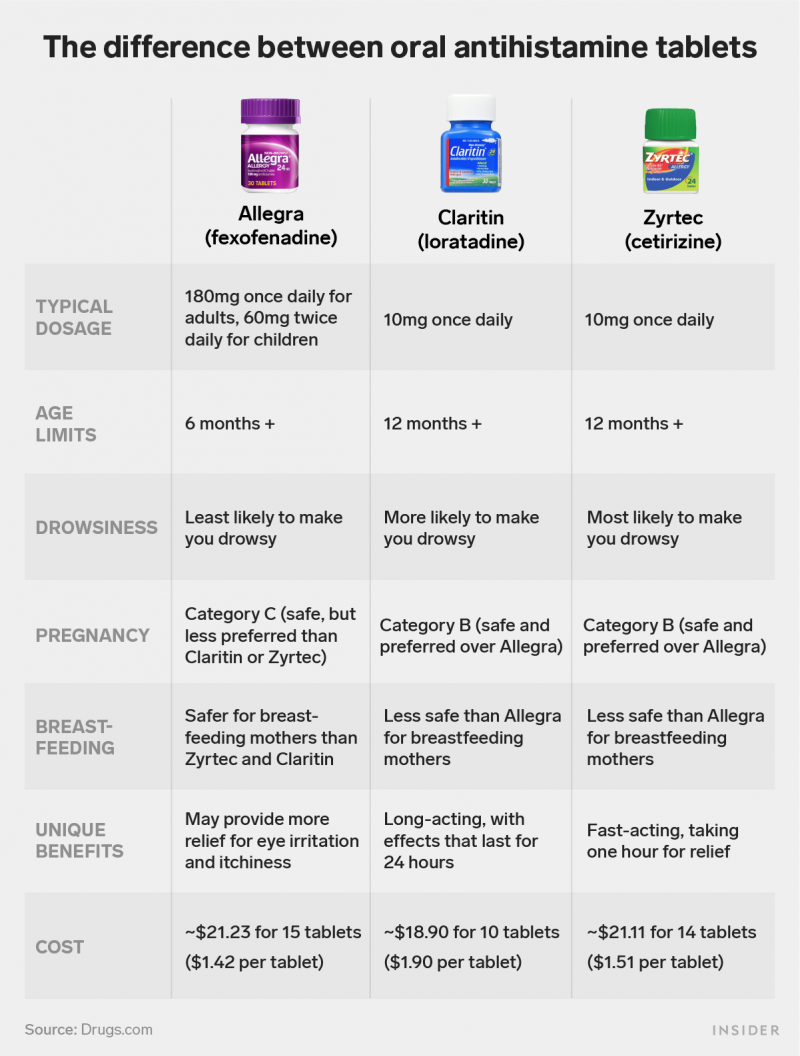- To figure out what allergy medicine you should take, it’s first important to consider your symptoms.
- You should take antihistamines if you have a runny nose, itchy or watery eyes, and are sneezing.
- You may also want to take decongestants or try a nasal spray if you have nasal congestion and a stuffy nose.
- This article was medically reviewed by Omid Mehdizadeh, MD, otolaryngologist and laryngologist at the Pacific Neuroscience Institute’s Pacific Eye, Ear & Skull Base Center at Providence Saint John’s Health Center in Santa Monica, CA.
- Visit Insider’s Health Reference library for more advice.
If you have seasonal allergies, or hay fever, choosing the right allergy medicine can be important to get you through the day.
While allergy medicine doesn’t cure allergies, it does provide relief from the major symptoms, including:
- Sneezing
- Runny nose
- Stuffy or congested nose
- Shortness of breath
- Watery, itchy eyes
- Scratchiness or irritation in the roof of mouth, throat, or ears
Antihistamines – like Claritin, Allegra, or Zyrtec – can reduce most of these allergy symptoms and will likely be your first option. However, if nasal congestion or a stuffy nose is one of your main symptoms, decongestants or nasal sprays may also be helpful.
Here’s what you need to know about the different types of allergy medication and how to figure out which you should take.
When you should take antihistamines
Antihistamines are the first line of defense for seasonal allergies. They help block histamines, which are released by your immune system and cause the main symptoms during an allergic reaction.
Common antihistamines that are available without a prescription include:
- Allegra (active ingredient: fexofenadine)
- Claritin (active ingredient: loratadine)
- Zyrtec (active ingredient: cetirizine)
- Xyzal (active ingredient: levocetirizine)
This allergy medicine is available in tablet form, which starts working within one hour, and as a nasal spray, which can provide relief within 15 minutes.
Antihistamines work best when you take them before you feel a reaction, so they can build up in your blood to block the release of histamines. That means knowing when allergy season is, what triggers your allergies, and monitoring pollen or mold counts from weather reports.
"Even if it means taking a bit more than necessary, it's always best to start early," says Gary Stadtmauer, MD, FACP, a board-certified specialist in allergy-immunology and internal medicine at City Allergy.
If you are pregnant or breastfeeding, consult with your doctor before taking an antihistamine.
Drowsy vs. non-drowsy antihistamines
Older types of antihistamines, known as first-generation antihistamines, can act as a sedative, and are also available over-the-counter (OTC).
This medicine, such as diphenhydramine - like Benadryl - causes you to feel drowsy and is best taken before bed if, for instance, your allergy symptoms are reducing the quality of your sleep. This can be particularly helpful for children who suffer from allergy symptoms.
However, they may also have more side effects for children. For example, studies have found poorer school performance in children with allergic rhinitis using sedating antihistamines when compared to children treated with non-sedating antihistamines, or healthy children.
You'll definitely want to check in with your doctor before taking drowsy antihistamines, as they can also be harmful for older adults.
Overall, it's best to stick to non-drowsy antihistamines. However, there are still so many different types sold in stores - here's a further breakdown of the most common antihistamines.
What's the difference between allegra, claritin, and zyrtec?
While Allegra, Claritin, and Zyrtec are all in the same family of drugs - antihistamines - they each have different active ingredients, and there are some differences between them.
Use this chart to figure out which oral antihistamine tablet you should take:

You should also consider whether any other medications you're taking might interact poorly with Allegra, Claritin, or Zyrtec.
Don't hesitate to use generic brands
The same antihistamine in Zyrtec, for example, is available as Aller-Tec at Costco, and as Wal-Zyr at Walgreens.
These generic brands will have the same active ingredients as their branded counterparts, and are just as effective, while saving you money. The average monthly cost of generic cetirizine, for example, is $11, while its branded version, Zyrtec, is $19.
Choosing the right medication can be a process of trial and error. If you do switch between different types, it's important to read all the instructions on the safe daily dosage, and carefully monitor how much you're taking in total.
The key is to pay attention to what actually works for you - keeping a diary of how effective they are at providing relief might be helpful.
When you should take decongestants
If you're stuffed up and struggle to breathe through your nose with allergies, you might want to consider a decongestant in addition to antihistamines.
Decongestants target the relief of a stuffy nose and sinus congestion by shrinking the blood vessels and tissue inside your nose, allowing more air to pass through and making it easier to breathe.
Taken together with antihistamines, they are more effective at reducing nasal congestion and other seasonal allergy symptoms, according to Atul N. Shah, MD, an allergy specialist and founder of the Center for Asthma & Allergy.
Decongestants are available in tablet form, as a nasal spray, or nose drops. The nasal sprays and nose drops are only suitable for a short period of time, specifically no more than four consecutive days, warns The American Academy of Allergy, Asthma, and Immunology (AAAAI).
These are some of the most common decongestants available OTC:
- Afrin nasal spray
- Sudafed (active ingredient: pseudoephedrine)
- Sudafed PE (active ingredient: phenylephrine)
- Zyrtec-D (active ingredients: cetirizine with pseudoephedrine)
You can also take medicine that combines antihistamine and decongestant all-in-one. These medications are usually marked with a "D" - such as Claritin-D, Allegra-D, and Zyrtec-D. For a long list of what's available, have a look here.
When you should use corticosteroids nasal sprays
Corticosteroid nasal sprays can also help reduce congestion and sneezing. They contain an anti-inflammatory steroid hormone which reduces the swelling in the mucous membranes within your nose.
They take longer to work than antihistamines and decongestants - people usually notice a difference within twelve hours but the full effect is reached after a few days.
As with antihistamines, they should be taken two to four weeks before allergy season starts to be fully effective. They can also be used alongside antihistamines, in place of a decongestant.
The following corticosteroid nasal sprays are available over the counter:
- ClariSpray (active ingredient: fluticasone)
- Flonase (active ingredient: fluticasone)
- Nasacort (active ingredient: triamcinolone)
If you are pregnant or breastfeeding, consult with your doctor before using any nasal spray and ask your health care provider about corticosteroid nasal sprays that are safe for your child.
The bottom line
If these common allergy medications don't reduce your symptoms, your doctor may recommend a stronger prescription medicine for you.
Alternatively, allergy shots (immunotherapy) is another way to relieve allergy symptoms. These injection treatments regulate your allergies in the long term and help prevent flare-ups in your symptoms each allergy season.
In addition, allergy tests can help pinpoint exactly what's triggering your sensitivities and guide your treatment plan. These tests are usually done under the guidance of an allergy specialist.
Related articles from our Health Reference library:
- The 3 best types of eye drops for allergies - and how each can reduce eye allergy symptoms
- What are antihistamines? How to use the best medication for seasonal allergy relief
- How to use nasal spray correctly - and how often you need to use each type
- All the ways you can control your allergies, from air filters to saltwater rinses

